Introduction
The retail industry is undergoing a major transformation driven by AI, which is rapidly becoming a key element of successful retail strategies.
Once considered futuristic, AI now impacts every aspect of retail, from customer interactions to supply chain management.
Early innovations by companies like Amazon, Walmart, and Macy’s laid the foundation for today’s AI-driven landscape.
With the rise of ChatGPT in 2022, AI adoption accelerated, enhancing retail operations and customer experiences, and it’s expected to significantly drive revenue growth in the future.
This post explores AI’s applications, benefits, challenges, and future trends, providing a guide for retailers to navigate the AI-powered future.
What is AI and Why Does It Matter in Retail?
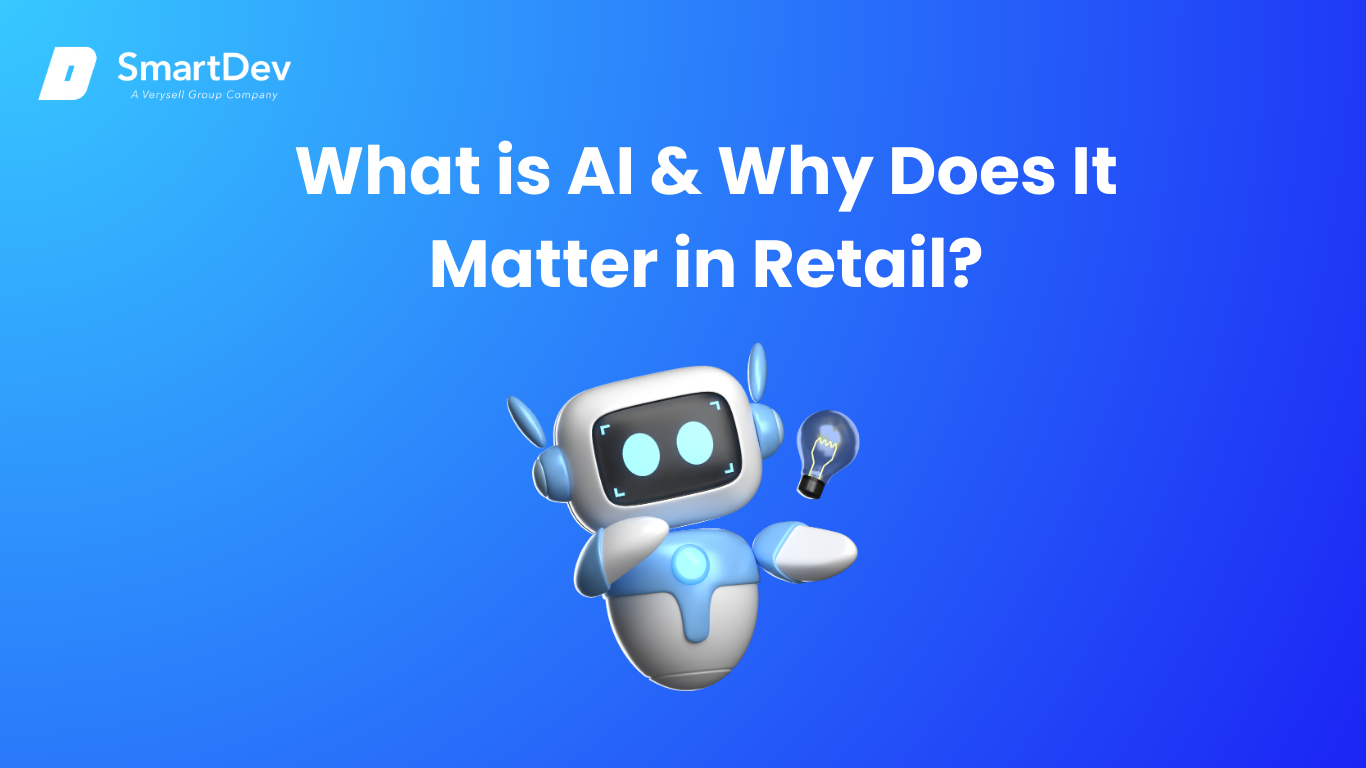
Definition of AI and its core technologies
Artificial Intelligence refers to the ability of machines to perform tasks that typically require human intelligence.
This can range from recognizing patterns and making decisions to understanding natural language and perceiving the world visually.
AI encompasses various core technologies, including machine learning (ML), natural language processing (NLP), and computer vision.
ML allows systems to learn from data and improve over time without explicit programming.
NLP enables machines to understand and generate human language, while computer vision empowers systems to interpret and act on visual data, such as images and videos, giving machines a sense of vision comparable to human perception.
The Growing Role of AI in Transforming Retail
AI is becoming an essential tool for retailers seeking to remain competitive in an increasingly digital world.
By automating processes, personalizing customer experiences, and optimizing supply chains, AI helps businesses streamline operations and respond more effectively to customer demands.
The integration of AI into retail allows for a deeper understanding of consumer behavior, driving smarter decisions about inventory, marketing, and even pricing.
Retailers can leverage AI’s capabilities to predict trends, improve sales forecasting, and enhance customer satisfaction, making AI not just a trend but a vital component for future success.
Key Statistics and Trends Highlighting AI Adoption in Retail
The pace of AI adoption in retail is accelerating rapidly.
A 2020 report from McKinsey revealed that around 30% of retail businesses had already implemented AI technologies, and another 40% planned to do so within the next two years.
AI-driven tools such as chatbots, recommendation engines, and personalized marketing campaigns are becoming increasingly common, improving customer engagement and driving revenue.
With AI’s ability to analyze large datasets and offer actionable insights, retailers can optimize operations and better understand their customers, which is why it is considered a key driver of business growth in the coming years.
Business Benefits of AI in Retail
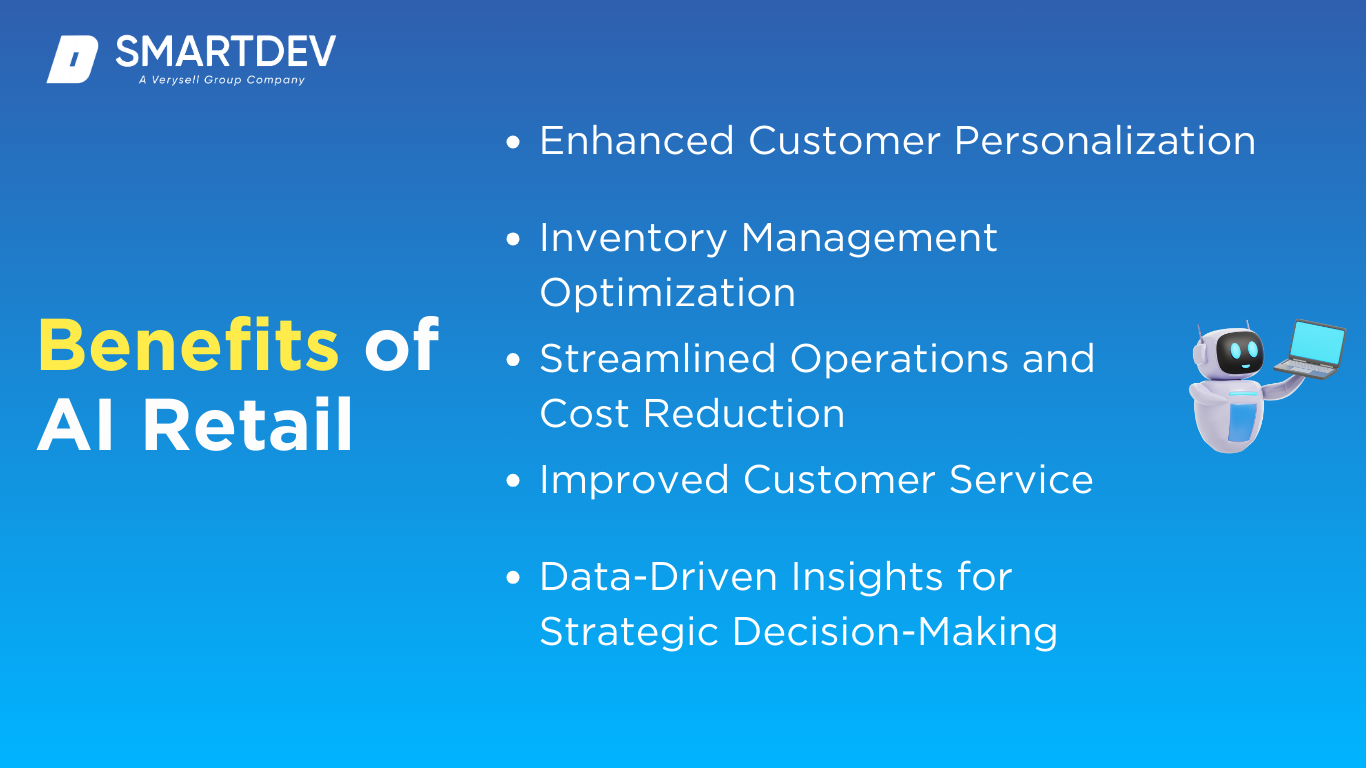
1. Enhanced Customer Personalization
AI enables retailers to deliver hyper-personalized shopping experiences by analyzing customer data such as purchase history, browsing habits, and social media interactions.
With this information, AI can provide tailored recommendations, personalized promotions, and targeted marketing strategies.
This not only enhances customer satisfaction but also increases conversion rates and boosts customer loyalty.
Personalization is now more than just a luxury – it’s an expectation from consumers who want relevant and meaningful shopping experiences.
2. Inventory Management Optimization
AI dramatically improves inventory management by predicting demand trends, optimizing stock levels, and reducing excess inventory.
Through machine learning models, retailers can accurately forecast future demand by analyzing historical sales data, seasonal trends, and even external factors like weather or events.
This leads to better stock management, fewer stockouts, and reduced waste.
By ensuring products are available when customers want them, AI helps retailers avoid missed sales opportunities and optimize their supply chain operations.
3. Streamlined Operations and Cost Reduction
AI-powered automation plays a pivotal role in streamlining retail operations.
From automated checkout systems to warehouse robotics, AI reduces the reliance on human labor, cutting operational costs and improving efficiency.
Automation not only speeds up routine tasks but also minimizes human errors, leading to a smoother, more accurate process.
By freeing up resources, retailers can allocate staff to more value-driven tasks, improving the overall performance of the business.
4. Improved Customer Service
AI-powered chatbots and virtual assistants offer 24/7 customer service, handling inquiries, troubleshooting issues, and providing product recommendations.
These AI systems can manage a range of tasks, from answering frequently asked questions to providing personalized advice based on customer preferences.
This leads to faster response times, a better customer experience, and reduced workloads for human customer service representatives.
With the added benefit of scalability, AI-driven customer service systems can handle large volumes of customer requests simultaneously, especially during peak times.
5. Data-Driven Insights for Strategic Decision-Making
AI provides businesses with powerful tools for data analytics, enabling retailers to extract valuable insights from vast amounts of consumer data.
Predictive analytics, for instance, helps retailers understand emerging market trends, customer preferences, and potential areas for growth.
These data-driven insights empower businesses to make more informed decisions regarding inventory, pricing, and marketing strategies.
By leveraging AI to gain deeper insights into consumer behavior, retailers can stay ahead of the competition and capitalize on new opportunities more effectively.
Challenges Facing AI Adoption in Retail
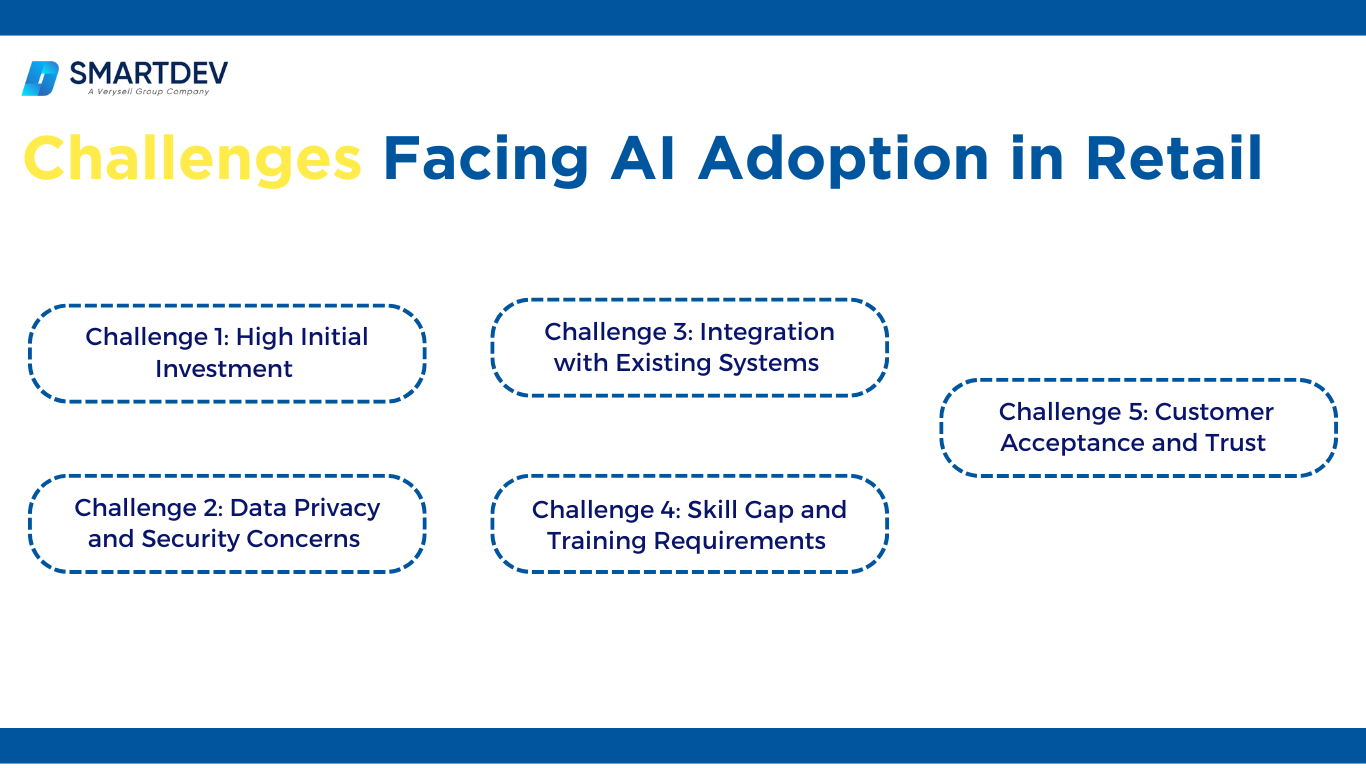
1. High Initial Investment
For many retailers, the cost of implementing AI technologies can be a significant barrier.
The initial investment required for AI infrastructure, software, and skilled personnel can be prohibitive, particularly for small or medium-sized businesses.
While AI promises long-term savings and efficiency, the upfront costs for research, development, and implementation may deter many retailers from making the leap.
Despite these challenges, the long-term ROI often justifies the investment.
2. Data Privacy and Security Concerns
With the vast amounts of customer data required for AI to function effectively, privacy and security become major concerns.
Retailers must ensure that they comply with data protection regulations like GDPR and manage customer data responsibly.
Implementing AI without adequate security measures can lead to breaches that compromise customer trust.
Ensuring transparency and accountability in AI systems is essential to safeguarding sensitive customer data and maintaining a secure digital environment.
3. Integration with Existing Systems
Integrating AI into existing retail systems can be complex, especially for companies with legacy infrastructure.
Retailers often face difficulties aligning new AI technologies with their current software, which may not be designed to accommodate the advanced needs of AI.
Successful AI adoption requires careful planning, testing, and sometimes the complete overhaul of outdated systems.
The integration process can be time-consuming and may require significant technical resources.
4. Skill Gap and Training Requirements
AI adoption necessitates a skilled workforce capable of managing and optimizing AI technologies.
Unfortunately, there is a significant shortage of qualified professionals in the AI field.
Retailers need to invest in upskilling their existing staff or hire AI experts to build and maintain AI systems.
Without the necessary talent, businesses may struggle to implement AI solutions effectively and maximize their potential benefits.
5. Customer Acceptance and Trust
Although AI can improve the customer experience, many consumers remain hesitant about interacting with AI systems.
Trust issues arise, particularly with AI-driven decision-making or chatbots replacing human interactions.
Retailers must work to build customer trust by being transparent about how AI systems operate and ensuring that customers feel comfortable with these technologies.
Education and clear communication about AI’s benefits and limitations can go a long way in addressing these concerns.
Specific Applications of AI in Retail
<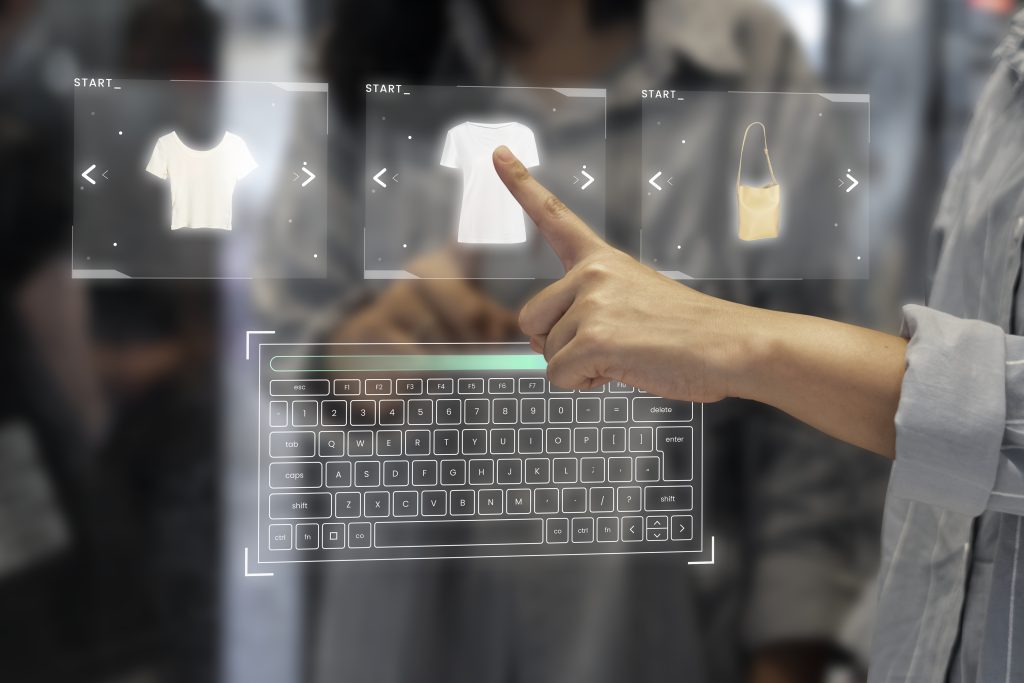
Use Case 1: AI-Powered Personalization Engines
Explanation of the Use Case
Personalization engines use AI to analyze customer behavior, including purchase history, browsing activity, and demographic data, to deliver tailored recommendations.
This creates an individualized shopping experience, making customers feel more engaged and understood. The system continuously learns from the data, further refining its recommendations over time, ensuring that each customer’s experience is relevant and personalized.
Real-World Examples or Case Studies
Retail giants like Amazon and Netflix leverage AI to power their recommendation engines.
Amazon’s recommendations drive a significant portion of its sales by offering personalized product suggestions that match individual customer preferences. Netflix’s algorithm works similarly, suggesting movies and shows based on viewing habits and ratings, increasing user engagement and retention.
Use Case 2: AI Chatbots for Customer Service
Explanation of the Use Case
AI chatbots provide real-time support for customers by handling common queries, processing orders, and assisting with troubleshooting.
These systems use NLP to understand and respond to customer inquiries in a human-like manner, providing immediate assistance without the need for human intervention.
Real-World Examples or Case Studies
Sephora’s Virtual Artist is an AI chatbot that helps customers choose makeup products that complement their skin tones.
The AI system allows users to upload selfies, and based on facial recognition technology, it recommends products tailored to individual features, enhancing the shopping experience and fostering a more personalized connection with customers.
Use Case 3: Predictive Analytics for Demand Forecasting
Explanation of the Use Case
AI-driven predictive analytics enables retailers to forecast customer demand with greater precision.
By analyzing historical data, trends, and external factors such as weather patterns or upcoming holidays, AI models can predict which products will be in demand. This allows businesses to optimize inventory, ensuring that they have the right products in stock at the right time.
Real-World Examples or Case Studies
Walmart has successfully implemented AI to forecast product demand, which allows the company to maintain optimal stock levels during high-demand periods like holidays.
This has led to better inventory management, fewer stockouts, and reduced waste, benefiting both the company and its customers.
Examples of AI in Retail
Real-World Case Studies
Many companies have successfully implemented AI in their retail operations.
For instance, Lowe’s, the home improvement retailer, uses robots equipped with AI to assist customers in stores.
These robots help shoppers find products, answer questions, and scan shelves for out-of-stock items.
Success Metrics and Outcomes By implementing AI-powered robots, Lowe’s has improved customer service and operational efficiency.
The robots have reduced the time customers spend searching for products, allowing employees to focus on more complex tasks.
Additionally, AI-driven inventory management has led to a reduction in stockouts and waste.
Innovative AI Solutions
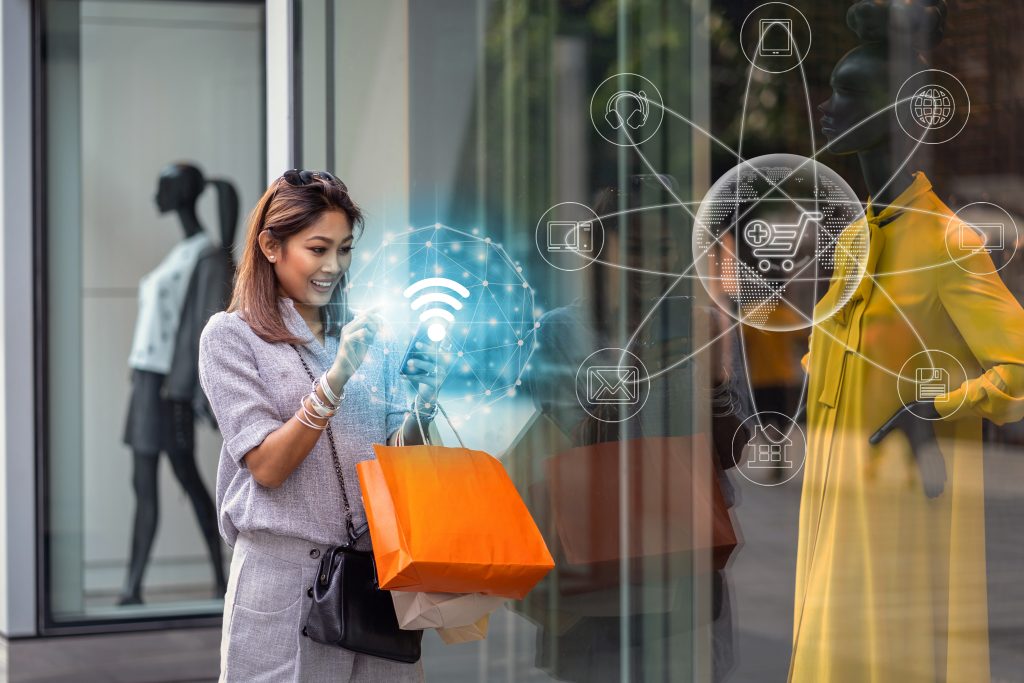
Emerging AI Technologies in Retail
The retail sector is constantly evolving, with new AI technologies emerging to address various challenges.
One notable example is AI-driven visual search technology, which allows customers to search for products by uploading images instead of typing keywords.
This innovation is enhancing the online shopping experience and helping retailers reach more customers.
How These Solutions Are Transforming Business Operations
AI-driven innovations are transforming the retail business model by improving personalization, reducing operational costs, and optimizing inventory.
These technologies are not just streamlining existing processes but are also opening new avenues for revenue growth and customer engagement.
AI-Driven Innovations Transforming Retail

Emerging AI Technologies in Retail
The retail sector is constantly evolving, with new AI technologies emerging to address various challenges.
One notable example is AI-driven visual search technology, which allows customers to search for products by uploading images instead of typing keywords.
This innovation is enhancing the online shopping experience and helping retailers reach more customers.
How These Solutions Are Transforming Business Operations
AI-driven innovations are transforming the retail business model by improving personalization, reducing operational costs, and optimizing inventory.
These technologies are not just streamlining existing processes but are also opening new avenues for revenue growth and customer engagement.
How to Implement AI in Retail
1. Assessing Readiness for AI Adoption
Before implementing AI, retailers need to assess their readiness. This involves evaluating current infrastructure, data capabilities, and the potential impact on business operations.
A thorough assessment ensures that AI adoption aligns with strategic goals.
2. Identifying Business Areas Suitable for AI Integration
Retailers should identify business areas where AI can deliver the most value. This could include customer service, inventory management, or marketing.
By focusing on high-impact areas, retailers can maximize the ROI of AI investments.
Measuring the ROI of AI in Retail
To measure the success of AI adoption, retailers should track key performance indicators (KPIs) such as sales growth, customer satisfaction, and cost savings.
Monitoring these metrics helps businesses understand the impact of AI and make data-driven decisions for future investments.
Many companies have reported significant returns on their AI investments.
For example, H&M used AI to optimize its supply chain, leading to improved inventory management and reduced waste, which contributed to a 15% reduction in operational costs.
Future Trends of AI in Retail

1. Predictions for the Next Decade
Over the next decade, AI is expected to become even more integrated into retail operations. We can expect to see more advanced personalization tools, AI-driven logistics, and enhanced customer service capabilities.
AI will continue to drive innovation, enabling retailers to stay competitive in an increasingly digital marketplace.
2. How Businesses Can Stay Ahead of the Curve
Retailers can stay ahead by continuously investing in AI technologies and keeping up with emerging trends. By fostering a culture of innovation and collaboration, businesses can ensure they are prepared to adapt to future developments in AI.
Conclusion
Key Takeaways
AI is revolutionizing the retail industry, offering numerous benefits, from enhanced customer experiences to improved operational efficiencies.
As AI technologies continue to evolve, retailers must embrace these innovations to stay competitive.
By understanding the potential applications and addressing the challenges associated with AI adoption, businesses can unlock new opportunities and drive growth in the ever-changing retail landscape.
Moving Forward: A Path to Progress
—








